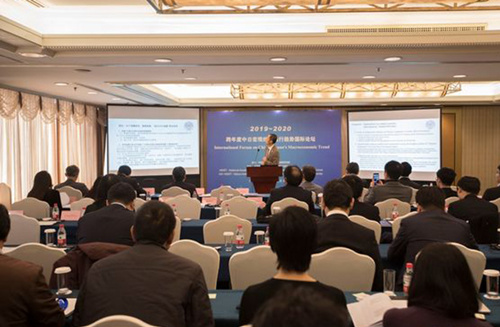
The International Forum on China-Japan Macroeconomic Trends was held in Beijing on Dec. 13. Photo: Wu Wenkang/CSST
More than 50 experts and scholars from China and Japan attended the International Forum on China-Japan Macroeconomic Trends in Beijing on Dec. 13, to discuss the current macroeconomic situation and prospects between China and Japan. Cai Fang, vice president of the Chinese Academy of Social Sciences (CASS), and Yusuke Kawamura, special director of the Daiwa Institute of Research Ltd, delivered keynote speeches on “facing the arrival of an aging society” and “the enlightenment of Japan-US trade friction to China” respectively.
Cai said that population aging is a long-term and irreversible trend common to countries around the world. Compared with other countries, China’s population is facing the situation of “being old before rich.” In other words, the current structure of China’s population, or its degree of aging, is closer to that of developed countries, but its economic development has not yet reached the level of developed countries. The only solution to deal with the dilemma is to innovate. The elderly should not be viewed as a dependent population, but as labor force and human capital. We can adopt appropriate economic and social policies to improve the labor participation rate of the elderly. Due to population aging, China is experiencing the decline of labor force participation, human capital and purchasing power, which has affected economic growth and the social ability to provide for the elderly adequately. Although this trend of decline relates to some general laws, it also involves the special situation of being old before being rich. It can be controlled through adjustments of policy such as raising the retirement age for a higher labor participation rate, training human capital throughout the full life cycle, extending the healthy life expectation of the population through more reasonable institutional arrangements, reinforcing the redistribution of national income and improving the coverage of social security.
Kawamura analyzed the background, process and consequences of Japan-US trade friction in the last half of the 20th century and Japan’s responses to US pressure. He said that this has great reference value for China as it deals with China-US trade friction. China and Japan should work together to build a forward-looking and win-win cooperation model. Scholars from both countries can discuss in depth how to deal with the issue of an aging society. In addition, there are many research topics in various fields such as economics and culture to conduct bilateral cooperation.
He Dexu, director of the National Academy of Economic Strategy at CASS, said that the current world economy is facing many factors of uncertainty. In this context, it is of great practical significance for Chinese and Japanese economists to jointly study the challenges facing the economic development of the two countries.
Wang Hongju, director of the Comprehensive Economic Research Office at the National Academy of Economic Strategy at CASS, analyzed the macroeconomic situation in China in 2019 and the macroeconomic trend in 2020, and he proposed certain countermeasures. Keiji Kanda, deputy manager of the Economic Investigation Department at Daiwa Institute of Research Ltd, estimated that Japan’s real economic growth rate will be 0.3% in 2020. He analyzed the factors influencing the mounting downward pressure on the Japanese economy, including China-US trade friction, the downturn of the Chinese economy and the raised consumption tax in Japan. Among them, an important factor is the aging of the Japanese population. Xue Jun, director of the Global Economic Research Center at Nankai University, with a database built by his academic team, analyzed the current situation of Chinese enterprises “going global” after China ’s accession into the World Trade Organization, and he forecasted China’s foreign direct investment over the next three years.
Zhang Bin, director of the Tax Research Office at the National Academy of Economic Strategy at CASS, introduced the process and effect of the reduction in taxes and administrative fees in China, analyzed the impact of the cut on the Chinese economy, and offered his suggestions about what the next step should be. Li Jinyong, a young scholar from the School of Economics at Nankai University, stated that according to data analysis there is a significant positive correlation between China’s foreign direct investment and regional innovation.
(Edited by YANG LANLAN)

